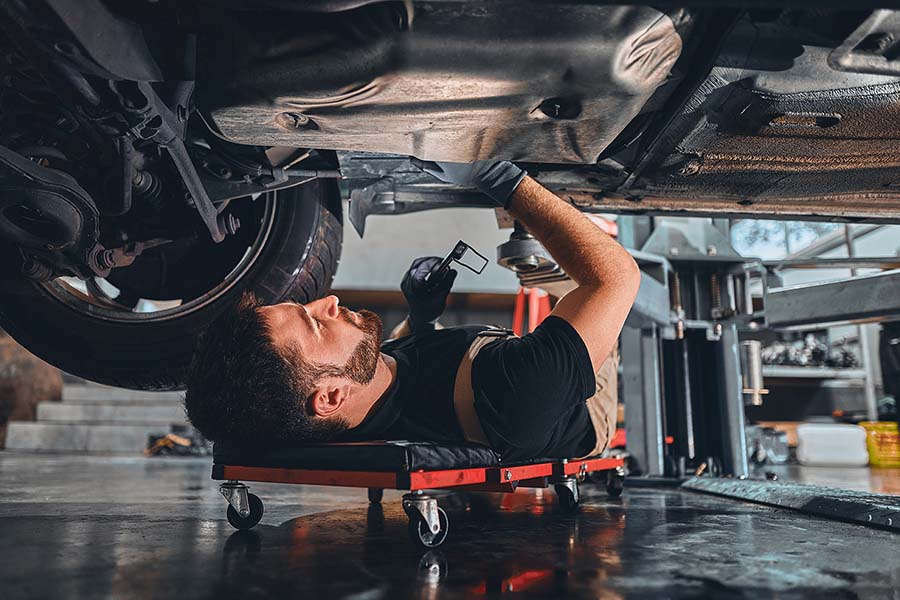The rules around MOTs—what’s tested and how often—depend on the vehicle’s MOT class. So if you’re asking yourself, “What MOT class is my vehicle?”, you’ve come to the right place.
We’re going to demystify the different classes and what they cover. And we’ll find out what they mean for when an MOT is due, and how much it will cost.
- Understanding MOT Classes
- What are the MOT categories?
- What class of MOT is a car?
- Is my car a class 4?
- Is my van a class 4 or a class 7 MOT?
- What difference does the MOT class make?
- How to answer, “What MOT class is my vehicle?”
- MOT Testing Requirements
Understanding MOT Classes
MOT classes are a way to categorize vehicles for testing purposes in the UK. These classes determine the type of vehicle and its weight to ensure it meets safety and environmental standards. There are eight MOT classes in the UK, each corresponding to a specific vehicle type. Understanding your vehicle’s MOT class is essential to ensure you get the right test and avoid any potential penalties. Knowing your MOT class helps you navigate the requirements and ensures your vehicle remains roadworthy and compliant with UK regulations.
What are the MOT categories?
The MOT categories are numbered 1 to 7. Here’s what they cover.
Class 1
Class 1 is the MOT for smaller mopeds and motorcycles. It covers bikes with an engine of up to 200 cc.
Most motorcyclists will be well aware of their vehicle’s engine size. But if you’ve picked up an older bike and aren’t sure, you can calculate it yourself.
Class 2
Class 2 is for motorcycles with an engine bigger than 200 cc.
If your bike has a sidecar, both class 1 and class 2 MOTs will also check that it’s properly secured and aligned.
Class 3
Class 3 is for vehicles with three wheels that weigh less than 450 kilograms.
Remember Del Boy’s three-wheeler Reliant Regal van in Only Fools and Horses? That’s one example of a vehicle that would be covered by a class 3 MOT.
Class 4
Class 4 is the most common MOT class, and it covers a variety of different types of vehicles:
- Cars able to carry up to 8 passengers (as long as they’re not three-wheelers weighing under 450 kilograms)
- Private passenger vehicles with up to 12 seats. If they also need a seatbelt installation check, they’ll have a class 4A MOT
- Three-wheeled vehicles over 450 kilograms
- Campervans, RVs and campers (note that caravans don’t need an MOT)
- Service vehicles like taxis and ambulances
- Goods vehicles with a Maximum Authorised Mass of up to 3,000kg
Class 5
Class 5 is for larger vehicles that carry more passengers or perform special jobs. They include:
- Private passenger vehicles and ambulances with more than 12 seats. If they also need a seatbelt installation check, they will have a class 5A MOT
- Coaches
- Playbuses
Class 6
Class 6 MOTs are for public service vehicles only. They’re carried out by the Driver and Vehicle Standards Agency, the DVSA, at approved centres.
Class 7
Class 7 covers larger goods and services vehicles, those weighing between 3,001 and 3,500 kilograms.
What class of MOT is a car?

In most cases, cars will fit into MOT class 4. But there are some exceptions.
Most cars these days have four wheels. But there are some unusual three-wheeler models, like the Morgan Super 3 or the Vanderhall Venice. Both these cars, though, weigh well over 450 kilograms, so they’d still be in Class 4.
Older three-wheeled models, like the Reliant Robin, however, slip beneath the 450 kilogram threshold. If you own one of these, it will be in MOT class 3. (Check out our classic and vintage car insurance for specialised cover.)
At the other end of the scale, cars with more than 12 seats would need a class 5 MOT. That would include 13-seater stretch limousines, or 16-seater stretch Humvees.
Is my car a class 4?
As long as your car has four wheels and eight seats or fewer, it will fit into class 4. And if your car has three wheels and weighs over 450 kilograms, it will fit into class 4 too.
But if it also needs a seatbelt installation check, it will need a class 4A MOT.
That will be the case if it has more than eight seats, more seatbelts than the minimum required, and was first used before 1 October 2001. As well as meeting those criteria, one of the following must apply:
- the car was not fitted with type-approved seat belt anchorage points when it was built
- there’s no proof that a seatbelt installation check has been carried out on the car before
- extra seat belts have been fitted since the last MOT.
Is my van a class 4 or a class 7 MOT?
If you’re asking yourself, “What MOT class is my van?” there are two possible answers. It could fit into either class 4 or class 7.
As with other goods and services vehicles, the answer depends on its weight. More specifically, it depends on its Maximum Authorised Mass. You may also hear this referred to as the Gross Vehicle Weight or “maximum permissible mass”.
Dual purpose vehicles are categorized based on passenger capacity and may fall under different MOT classes.
That’s the weight of the vehicle when it’s holding the biggest load it can carry safely. That isn’t something you assess yourself. It’s done by the vehicle manufacturers and it will be listed in the owner’s manual. It’s sometimes also set out on a sticker or plate on the vehicle itself.
If your van’s maximum authorised mass is 3,000 kilograms or less, it will be in MOT class 4. If it’s 3,001 kilograms or more, it will be in class 7.
What difference does the MOT class make?
The MOT test will check some of the important parts of your vehicle to make sure they’re safe. The checks that will be carried out are set out in the DVSA’s MOT instruction manuals.
For vehicles in classes 1 and 2, the MOT will follow the instruction manual for motorcycles. For vehicles in classes 3, 4, 5 and 7, there’s an MOT instruction manual for cars, private buses and light commercial vehicles.
The MOT class also affects the price of the MOT check, and how often a vehicle has to have one.
How does the MOT class affect the price of the test?
The DVSA sets maximum fees that garages can charge for an MOT check.
A class 1 MOT is the cheapest. The maximum prices increase through MOT classes 2, 4, and 5. The maximum for class 7 MOTs is slightly higher than for a standard class 4 MOT.
Because of the variety of vehicle types they cover, class 4 and class 5 MOTs have a range of maximum fees.
Maximum prices for class 4 MOTs increase for vehicles with more than 8 seats. And they’re higher again if your vehicle also needs a seatbelt installation check.
In class 5, prices increase for playbuses, and for passenger vehicles with more than 16 seats. And a seatbelt installation check will cost you extra in this case too.
You can find the latest maximum fees on the gov.uk website. Some garages offer discounts if you have your MOT and your service carried out at the same time.
How does the MOT class affect when vehicles need their MOT?
Most vehicles need to have their first MOT three years after they’re first registered. After that, an MOT is required once a year.
But there are some exceptions to this rule. And your MOT class will help determine when a check is required.
All vehicles in classes 1, 2, 3 and 7 need their first MOT after three years. And they’ll all need an annual MOT after that.
For vehicles in classes 4 and 5, the picture is a little more complicated. Some vehicles need their first MOT a year after they’re first registered, and every year afterwards. The vehicles that fit into this category are:
- Ambulances
- Taxis
- Playbuses
- Private passenger vehicles with more than eight seats.
What is the MOT class for a lorry?
The MOT classes only cover light commercial vehicles with a Maximum Authorised Mass of 3,500 kilograms. That’s because lorries and other larger vehicles have a different test, the “annual test” for heavy goods vehicles, buses and trailers.
If you have a vehicle that needs an annual test, note that it needs to be cleaned beforehand. The dashboard, vehicle controls and doors have to be wiped down. And the dashboard, footwells, seats and door pockets should be cleared of what the DVSA call “unnecessary items”.
Don’t try and skip the cleaning. If the vehicle isn’t presented in a suitable state of cleanliness, the test will be cancelled and you’ll lose your fee.
How to answer, “What MOT class is my vehicle?”
For most people, it’s fairly easy to answer the question of “What MOT class is my vehicle?”
If you’re a car owner, it will almost certainly be class 4. The only exceptions are if you have a light three-wheeled vehicle, or a car with more than eight seats.
For motorcycles, it will be class 1 or 2, depending on the engine size. And for vans, it will be class 4 or 7, depending on the weight when it’s fully loaded.
MOT Testing Requirements
MOT testing is a legal requirement for vehicles three years old or more to continue driving on the road. The test ensures vehicles meet minimum requirements for environmental standards and road safety. Failure to take a vehicle for its MOT every year results in a fixed penalty if caught using it on the road once the certificate runs out. MOT testing requirements vary depending on the vehicle type and weight, so it’s essential to check your vehicle’s MOT class before booking a test. This ensures you meet all legal obligations and keep your vehicle in top condition.
What to Expect During an MOT Test
During an MOT test, a qualified examiner will inspect your vehicle to ensure it meets the minimum safety and environmental standards. The test covers various aspects of your vehicle, including the brakes, suspension, steering, and exhaust system. The examiner will also check your vehicle’s lights, tyres, and seatbelts to ensure they are in good condition. If your vehicle passes the test, you will receive a valid MOT certificate, which is essential for renewing your road tax and avoiding penalties. Understanding what to expect can help you prepare and ensure a smoother testing process.
Have you got more questions about how MOTs work? Read our MOT FAQs page.
Also read:
- Driving without a valid MOT: what you need to know
- How long does an MOT take?
- Free MOT status checker – Check a vehicle’s MOT history
- MOT FAQs – Everything you need to know about MOTs
- Try our free-to-use Car Tax Checker
- Car Insurance Group Checker
- Car Insurance Groups [A Complete Guide]
- Class 7 MOTs: Your Complete Guide
- How to report a car with no MOT
- Your guide to car insurance for 17 year olds
- Car insurance for women
- Car insurance for test drives


